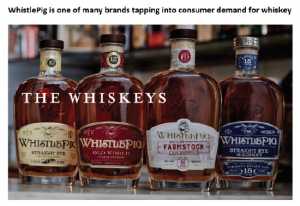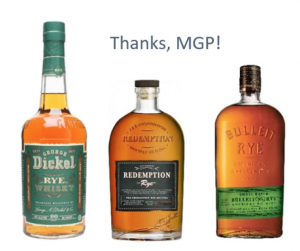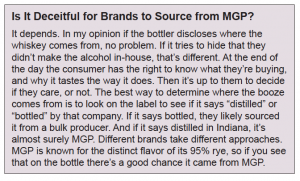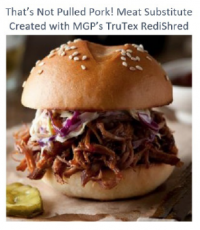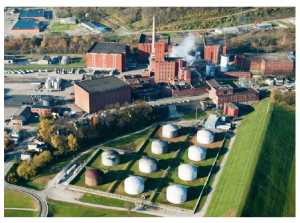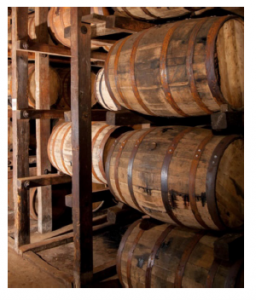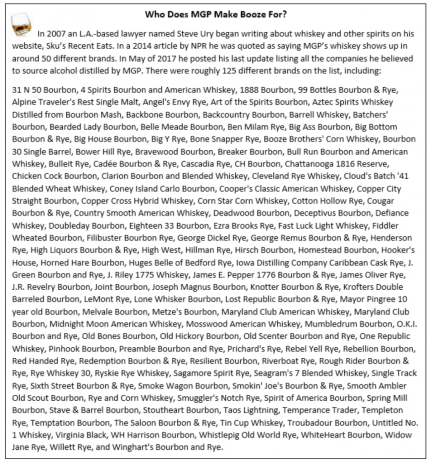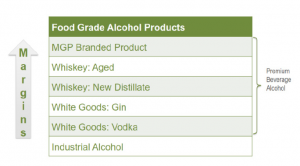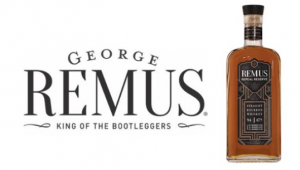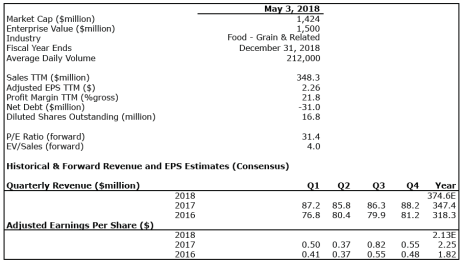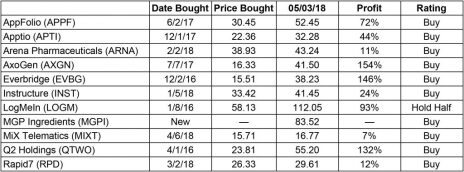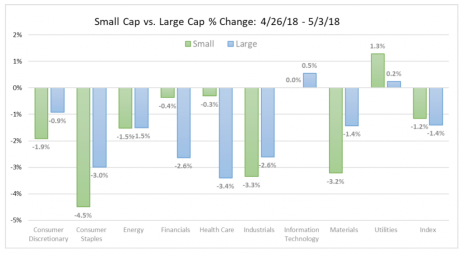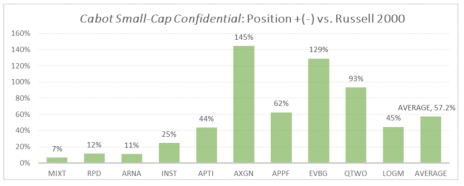If you want to invest in the whiskey trend, and a select few food trends, there’s really only one way to do it. That’s to buy shares in the company I’m profiling in this month’s Issue of Cabot Small-Cap Confidential. All the, oaky, spicy, and bold details are inside.
Cabot Small Cap Confidential 228
[premium_html_toc post_id="149628"]
THE BIG IDEA
You’re as smooth as Tennessee whiskey,
You’re as sweet as strawberry wine,
You’re as warm as a glass of brandy,
And I stay stoned on your love all the time.
- Lyrics from Tennessee Whiskey, originally recorded by David Allen Coe, 1981
A few weeks ago, I heard a familiar line coming from the back seat. But the voice and the lyrics didn’t quite match up. It was my five-year old son, gently singing the lines above, from David Allen Coe’s classic song Tennessee Whiskey.
The song has been covered by various artists since Coe first recorded it in 1981. But to my ears, his version is still the best. He has the voice of someone you can imagine drinks a lot of whiskey. Which is in sharp contrast to the voice coming from the back seat!
I’m more of a beer guy, and don’t drink much whiskey. Based on consumer trends, it seems I’m missing out. In 2017, American whiskey sales were up 8.1% to $3.4 billion. And rye whiskey sales surged by 16.2%!
This demand hasn’t always been there.
In 1970, U.S. consumers purchased 35,600 cases of American whiskey. They loved the stuff. Then they discovered vodka, which went on a 30-year reign. By 2010, vodka had taken over the spirits market and had driven American whiskey volumes down to just 15,300 cases.
Then something strange happened. People began buying whiskey again.
Maybe it’s because distilling entrepreneurs saw that the craft beer movement was reaching its upper limits and the market was poised for something new. Maybe it’s because a strengthening economy helped drinkers crack their wallets a little wider for an expensive bottle of craft whiskey. Maybe it’s just that millennials really do love smoky booze and the sense of place that often accompanies a well-crafted marketing message, not to mention a cool bottle.
Whatever the reason, the numbers don’t lie.
In 2017, 23,200 cases of American whiskey were sold. The data shows that the five-year average growth rate of sales volume is accelerating, from 2.5% in 2012, to 5.1% in 2014, to 6.5% in 2017.
Last year, growth in high end premium American whiskey was 5.9%. Super premium American whiskey sales were up 18.3%!
I doubt the boom in whiskey sales is a passing fad. People aren’t just being tricked into drinking whiskey because of good marketing. There are too many smart people out there, spending too much money, when there are ample alternatives of really, really, good alcohols and beers, for the trend not to be real.
To be perfectly clear, it’s not just whiskeys that are flying off shelves. In general, spirits have been gaining market share versus beer for the last eight years. The fastest growing sales are for premium alcohol beverages, including whiskey, gin and vodka.
The challenge is that premium dark alcohols, like American whiskey and rye whiskey, can’t be made quickly. They need to be aged. With market demand highest for premium whiskey, the more time it can sit in a barrel, the better.
These industry dynamics mean a lot of whiskey supply has to come from larger distilleries that possess aged whiskey in barrels. At least until enough time passes for newer brands to age their own.
One small-cap company has grown to become the label behind the label of many craft whiskeys. It is now the largest U.S. supplier of whiskey and distilled gin, selling to both fledgling brands as well as some of the largest in the world.
Today, it has earned a place in Cabot Small-Cap Confidential.
THE COMPANY/PRODUCT
MGP Ingredients (MGPI), also known as Midwest Grain Products, is a $1.4 billion market cap company that makes premium distilled spirits, industrial alcohol, specialty wheat starches and specialty wheat proteins. Most of the company’s products are sold to distributors, or directly to manufacturers and processors of finished packaged goods and/or bakeries. MGP has also recently begun selling its own branded premium whiskey and vodka.
It’s not an ultra-rapid growth business, but rather a steady one, with operating leverage and growth in premium products driving faster bottom line growth. In 2017, revenue was up 9% to $347 million, while EPS was up 24% to $2.25. Revenue growth should be in the high single digits over each of the next two years. MGP also pays a modest quarterly dividend of $0.32, which equals a yield of 0.36% at the current stock price. The dividend has been going up.
The company’s beverage alcohol is the source of some of the finest vodkas, gins, bourbons and whiskeys in the world. It is the largest U.S. supplier of rye whiskey and distilled gin. And is the distiller for many of the premium brands you see at your local restaurants and liquor stores.
Do you drink George Dickel Rye? It starts with MGP whiskey before being charcoal filtered. How about Diego’s Bulleit 95 Rye? The whiskey in the bottle comes from MGP. Redemption Rye? Straight up MGP.
Why do companies use MGP’s alcohol instead of distilling it themselves? For starters, MGP offers very good alcohol. It has been doing it for a long time, has scale, has different barrels that help create unique blends, and it can store the booze for customers until it’s ready to be bottled.
Perhaps most importantly, by going to MGP upstart distillers don’t need to buy a still, learn how to use it, buy all the ingredients, ferment and distill the alcohol, then buy barrels and store the alcohol for years until it’s ready for eventual sale. That can take a decade, or more!
That math doesn’t always work for a business that just wants to get up and running and, let’s be honest, might be better at branding and marketing than breeding master distillers. How else does an up-and-coming brand offer a 15-year barrel-aged bourbon if it’s only been around for five years?
While craft whiskeys are a big part of the MGP story (distillery products generated 86% of 2017 revenue), they’re not the only part. Last year, 16% of revenue came from the company’s food ingredients business, which is responsible for many of the feel, taste and functional properties of many foods you find in restaurants, bakeries and supermarkets.
MGP’s food ingredients help bakers keep raisins dispersed evenly in dough, let bakers spread frostings, and are key components of salad dressings. They also enable companies to make so many of the meat alternatives that are gaining in popularity, and which come pretty darn close to looking, feeling and tasting like the real thing.
MGP Has A Long History
The company’s food ingredients business dates back to 1941, when it was founded by Cloud Cray in Atchison, Kansas. Cray saw rising demand for industrial alcohol as World War II ramped up. He purchased an existing plant in Atchison – which is in the heart of America’s grain belt – and renamed it the Midwest Solvents Company.
Production ramped up over the years and with a license to make beverage alcohol, followed by Kansas repealing the state’s prohibition amendment in 1949, Midwest Solvents was on the path to broadening its customer base well beyond industrial alcohol.
In 1953 the company began adding equipment to make vital wheat gluten, and by 1967 it was one of the largest operations of this type in the world. The addition of a wheat starch division further built out the food ingredients business. Then a new distillation unit doubled alcohol production capacity in 1968.
The company changed its name to Midwest Grain Products in 1985, then went public in 1988. Over the next decade it became more focused on bulk alcohol and value-added wheat starch and wheat protein. An explosion at the Atchison distillery in 2002 led to the construction of a state-of-the art distillery that now helps MGP produce some of the highest quality food grade alcohol in the world.
But the biggest development in recent years was the 2011 purchase of one of the country’s largest distilleries, located in Lawrenceburg, Indiana (shown in this picture). This facility includes distillation operations, bulk barrel warehousing, tank farm and grain storage facilities. And it made it possible for MGP to build out production of its premium bourbon and rye whiskeys.
Distillery Products Segment
MGP’s Distillery Products Segment produces premium bourbons, rye whiskeys, vodkas, gins, food grade industrial alcohols, fuel grade alcohol and distillers feed. It sells over 20 varieties of distilled alcohol, including 49% barley malt rye whiskey, 95% wheat whiskey, 95% rye whiskey, 15% rye corn whiskey, heritage 300 distilled gin, distilled citrus berry gin, and non-GMO project verified grain neutral spirits, among others. For food grade industrial alcohols, MGP sells more than 10 formulations of specialty denatured alcohols (SDA), including SDA-29 for use in vinegar, SDA-40-B for shampoo, and SDA-35-A for processing antibiotics, among others. This segment grew by 9.7% to $291 million in 2017, when it generated 84% of total sales.
Food Grade Alcohol & Warehouse Services:
The majority of MGP’s distillery capacity is dedicated to production of food grade alcohol, primarily premium beverage alcohols including bourbon and rye whiskeys, vodka and gin. Whiskey can be sold as unaged new distillate, which is then aged by MGP’s customers from two to four years.
However, most customers also enter into contracts for a variety of warehouse services, including barrel put away, barrel storage and barrel retrieval. If you want a fifteen-year straight rye whiskey, MGP will distill it, put it in barrels, and pull the barrels out for you when it’s ready.
MGP likely makes premium alcohol for well over 100 brands. In 2017, the company’s five largest distillery customers accounted for 24% of total sales. Since 2015 MGP has also produced its own branded alcohol products. This is a significant development, so I’ll talk at length about MGP’s branded alcohol plans in a minute.
Industrial Alcohol
MGP sells food grade industrial alcohol which is used as an ingredient in foods (such as vinegar, candy glazes and food flavorings), personal care products (things like hair spray, shampoo and hand sanitizers), cleaning solutions and pharmaceuticals (ethanol acts as a solvent for processing antibiotics, vaccines, pills, vitamins and more).
Fuel Grade Alcohol
The company also produces fuel grade alcohol, which is a co-product from alcohol processing operations at the Atchison facility. And it produces Distillers Feed, which comes from the mash from alcohol processing operations, and is typically sold to companies that process animal feeds as a high protein additive.
Ingredients Solutions Segment
MGP’s Ingredient Solutions Segment generated 16% of sales ($56.4 million) in 2017, an increase of 6.5%. The segment produces specialty wheat starches, specialty wheat proteins, commodity wheat starches and commodity wheat proteins. These products are used in just about every food product out there, from bread and pizza dough to gravies, pasta noodles, processed meats, cereals, nutritional bars and salad dressings. A big growth trend lately has been non-meat alternatives, which rely on MGP’s ingredients.
MGP’s food ingredients help determine an end food product’s nutritional profile, appearance, texture, tenderness, taste, palatability, cooking temp, stability, viscosity, binding and freeze-thaw characteristics. Consistent with the company’s strategy to maximize value of production volumes, it has been tilting ingredient production toward high fiber, high protein, plant-based proteins, and non-GMO products. Average estimated five-year growth rates for these categories are 13%, 7%, 7.7% and 12.9%, respectively.
Specialty Wheat Starches
Wheat starch comes from the carb-bearing part of wheat flower. MGP’s premium wheat starch is sold under the trademarks Fibersym Resistant Starch, FiberRite RW Resistant Starch, Pregel Instant Starch, and Midsol Cook-up Starch. These starches are used in a wide variety of baked goods. Fibersym has been a particularly strong selling product lately, driven by consumer demand for more fiber in their diet.
Specialty Wheat Proteins
MGP’s wheat proteins are derived from vital wheat gluten (a light tan powder containing roughly 70% to 80% protein) through a variety of proprietary processes that change its molecular structure. Vital wheat gluten can be added to baked goods, pet foods, cereals and other foods to improve the nutritional content, texture, strength and volume of the finished good. The cohesiveness and elasticity of the gluten helps products rise and support other ingredients, such as raisins, cracked grains, nuts, etc. For instance, by varying the gluten content of the dough with MGP’s wheat proteins, bakers can customize their finished goods.
The company’s TruTex product line is used as a meat replacement for vegetarian products since it offers protein and replicates the look and texture of many meats, including beef, pork, poultry and seafood. This product has been selling like hotcakes, with sales doubling in Q1 2018.
MGP’s Arise product line is used in things like breads, flour tortillas, pizza crust, noodles, pretzels, energy bars, cereals and instant drinks. It can fully replace dried egg whites, and improves dough extensibility, product volume, uniformity and texture.
In June 2017 MGP added a couple of varieties of Non-GMO Project Verified products under the Arise brand, and in September 2017 it added several more to the TruTex line.
Growth Initiatives
Growth Initiative #1: Shifting Focus to High-Value Distillery Products
MGP has been working to sell more higher value alcohol products and less industrial alcohol. The highest margins come with its own branded whiskeys, followed by aged whiskeys.
The company’s sales trends tell the story. In 2014, roughly half of MGP’s alcohol sales came from premium beverages and net profit margin was 7.6%. Last year, 70% of alcohol sales were premium beverages and net profit margin was 11.1%. Within premium beverage alcohols, high-margin whiskey generated 64% of 2017 segment net sales.
It appears MGP is in the middle innings of this transition. Sales of premium distillery products should continue to go up, driven by new customers, growth from existing customers, greater sales mix of aged distillery products, and, hopefully, growth of MGP’s own branded products.
Growth Initiative #2: Launching In-House Brands to Capture Value
In 2015 MGP began producing and selling its own branded alcohol products. Depending on the brand, MGP has been selling its premium spirits in Ohio, Kentucky, Indiana, Kansas, Missouri, Wisconsin, Nebraska, Minnesota, Iowa and Connecticut. In Q1 2018, distribution was expanded to Illinois, Colorado and Arizona.
TILL American Wheat Vodka was launched in the second half of 2016 in select markets at a price around $35. It is marketed as a brand representing timeless and aspirational values. It uses wheat only from Kansas farms, and features a grainy wheat bread scent with a touch of vanilla and mocha latte.
George Remus Straight Bourbon Whiskey was re-launched in June 2017, a year after MGP acquired the whiskey label from Queen City Whiskey. It is a complex bourbon whiskey featuring the high-rye profile that MGP’s Lawrenceburg facility is known for.
Remus Repeal Reserve Straight Bourbon Whiskey hit the market with a limited release in September 2017. It is also distilled in Lawrenceburg.
Tanner’s Creek Blended Bourbon Whiskey was released in November 2017 and reflects MGP’s high-rye style of bourbon. It is named for an Indiana waterway that has ties to the early days of American distilling.
Growth Initiative #3: Expanding Warehouse Space and Inventory to Meet Future Demand
As demand for American whiskey grows, MGP is building out its storage capacity and has invested over $26 million to refurbish existing warehouses and build new ones. The company has also been distilling, barreling and storing inventory of premium bourbon and rye whiskeys for the future. In 2017 inventory of these alcohols grew by $14.8 million (at cost). At the end of Q1 2018 MGP disclosed it has $68 million in barreled distillate in inventory. To achieve this strategy, MGP must strike a balance each quarter by not selling all of the newly distilled alcohol it makes, which may drive some volatility in quarterly sales.
The Business Model
MGP makes and sells alcohol and food ingredients directly to manufacturers and processors of finished packaged goods and/or bakeries. The company has also begun selling its own branded premium whiskey and vodka. Supply contracts with premium alcohol beverage customers can be monthly, yearly, or multi-year, with periodic pricing review, and MGP recognizes revenue from warehouse storage services over time. In the Ingredients Solutions segment, contracts are usually price, volume and term agreements, for periods of three to six months. Because it is a key player in the supply chain for both alcohol and food ingredients, MGP functions like a strategic partner to many customers. That said, it doesn’t have long-term contracts, so it maintains its independence and flexibility to adapt to market conditions.
The Bottom Line
In 2017 MGP grew revenues by 9.2% to $347.4 million, driven by a 9.7% increase in sales of distillery products and a 6.5% increase in sales of food ingredients. Within distilled products, sales of premium beverage alcohol drove growth, up 18.4%, while sales of industrial alcohol were flat. Gross profit margin in this segment improved from 21.4% to 23%. In food ingredients, gross profit margin improved from 15.9% to 16.3%. EPS in 2017 grew by 24% to $2.44 and was helped by the sale of a non-core business. This growth profile was consistent with MGP’s strategic plan.
In Q1 2018, which was reported on Wednesday night, results came in lower than expected due to the timing of customer orders in the distillery segment. Revenue growth of 1% to $88 million missed by $4.8 million, while EPS of $0.52 missed by a penny, despite the benefit of a lower tax rate. By segment, sales of distillery products were up 0.6% while sales of food ingredients were up 2.7%. Distillery segment gross profit dipped to 21.3% from 22.5%, while food ingredient gross profit margin surged to 22.7% from 18.4% as demand for value-added wheat proteins and fibers jumped. The company ended the quarter with almost $68 million in aged whiskey in inventory (at cost).
Despite the Q1 miss, management reiterated its prior guidance, which calls for 2018 revenue growth in the high single digits and operating income growth of 10% to 15%. In 2019, management still sees 15% to 20% operating income growth, driven in large part by sales of more valuable aged whiskey.
Naturally, there was a lot of talk about the timing of customer orders on the conference call as analysts tried to feel out whether or not there is a negative change occurring in the underlying business. Based on my analysis, I don’t think there is (otherwise I wouldn’t recommend the stock this month!). MGP is trying to limit sales of lightly aged whiskey so it can increase sales of higher-value, aged whiskeys, and grow distribution of its own brands. These factors, along with a reasonable amount of quarter to quarter variability in customer orders, seem like a straightforward explanation for the Q1 “miss”. Management said its customer count is increasing, and it added more new customers in Q1 2018 than in Q1 2017.
MGP has two new rye whiskeys set to be released this month. And it is expanding distribution of its existing stable of brands. Combined, this means more in-house brands selling throughout a bigger distribution network. That’s good, and it’s going to be very interesting to hear the numbers when management is ready to share. As one analyst suggested, it appears that within a year MGP should be able to report materially higher gross margins in its distillery segment. The bottom line here is that business appears just fine.
RISK
Rising competition for value-added food ingredients: While MGP is benefitting from favorable consumer trends in its ingredients segment, such as demand for high fiber, high protein and non-GMO products, these trends aren’t guaranteed to last forever. Competition is likely to rise as other players capitalize on the same industry dynamics.
Change in premium alcohol consumption trends: Demand for American whiskey, and other premium alcohols, is very high right now. There’s no guarantee it will last forever. While demand appears to be stable, should consumer tastes change, MGP’s sales could be affected.
Growth in Craft Distiller Production Capacity: Many brands rely on MGP for some of their alcohol. As time goes by, more of these companies will have been able to distill and age some of their own alcohol, meaning they might become less reliant on MGP.
Change in Perception of MGP’s Role in Supply Chain: There have been many articles published about MGP’s role as a supplier to well-known, premium alcohol brands. Thus far, there hasn’t been a consumer backlash and/or resulting decrease in demand. But that could change in the future.
Manufacturing and Inventory Disruption: Accidents happen. Should one occur that causes manufacturing to stop for an extended time, or worse, destroy existing inventory, MGP’s operations would be severely disrupted.
COMPETITION
MGP competes against a wide number of players in the alcohol industry. In some respects, it competes against its own customers since they may decide to produce more alcohol in-house. It also competes against distilleries active in North America, such as Diageo, Brown-Forman and Alberta Distillers, who may produce for other customers. In the distillery products segment, competition is based on innovation, product characteristics, price, service and quality.
MGP also competes against many players, big and small, in the food ingredients industry who also make wheat starches and proteins, and in some cases corn starch, including Cargill, Archer Daniels Midland and Ingredion. As in the distillery segment, competition is based on innovation, product characteristics, price, name, color, flavor and how MGP’s ingredients will help determine the defining characteristics of end products.
THE STOCK
Trading Volume: MGP Ingredients has a market cap of $1.4 billion and trades an average of 212,000 shares daily. That means roughly $18 million worth of stock trades each day. Our subscriber group shouldn’t move this stock. Heavy days are +500,000 shares, and that’s occurred four days over the last six months, including two days in March when a total of nearly 3.5 million shares traded hands.
Historical Price: MGPI has a tendency to go on a run then consolidate for a few months. It also occasionally takes a dive after reporting earnings, as was the case after the Q4 2017 report and this Wednesday’s Q1 2018 report. Generally speaking, the trend is up and shares haven’t touched their 200-day line since the middle of 2015. For the last twelve months MGPI has traded mostly above its 50-day line, with dips below that technical level occurring in June, March and right now. Rebasing and/or consolidation periods occurred in August and September, November and December, and February and March. The latest breakout came around March 16 when MGPI jumped through 90. With a pattern of higher highs and higher lows holding up thus far, the evidence suggests the current post-earning dip to around the 50-day line near 85 will last for a number of weeks and provide opportunities for new positions to be established.
Valuation and Projected Price Target: Shares of MGPI trade with a forward PE of around 31 based on consensus estimates for EPS of $2.68 in 2019. Given that profit growth is expected to rise considerably in the coming years and that dividend payments could go up, the stock isn’t cheap. Fair value will simply be what the market is willing to pay. With what appears to be ample demand from institutions, a near-term price target of $100 seems quite reasonable, which implies a forward PE multiple of 37. That price target should creep up once the hangover from the Q1 report is washed away, which I suspect will occur if/when Q2 earnings show that the company is indeed still on track to meet its 2018 guidance. At that point I expect to revisit the price target, which should bump up considerably.
Buy Range (next two months): My wide preferred buy range is between 75 and 95, which brings us down near the 200-day line and the March dip, and up to the recent 52-week high. That’s a wide range! But it gives some indication of where the stock could trade in the coming weeks. A more likely buy range is in the 80 to 90 area, which gives us roughly 6% above and below the 50-day line to establish a position. Average in.
The Next Event: With the Q1 2018 earnings report and conference call occurring this past Wednesday there is nothing on the near-term schedule.
MGP Ingredients (MGPI) Financials
MGP Ingredients (MGPI) |
UPDATES ON CURRENT RECOMMENDATIONS
Due to the nature of the stocks recommended, it is to your advantage not to share these recommendations.
Buy means accumulate shares at or around the current price.
Hold means just that; hold what you have. Don’t buy, or sell, shares.
Sell means the original reasons for buying the stock no longer apply, and I recommend exiting the position.
Sell a Half means it’s time to take partial profits. Sell half (or whatever portion feels right to you) to lock in a gain, and hold on to the rest until another ratings change is issued.
I thought we were doing pretty well as this week progressed. But I didn’t realize just how well relative to the broad market until I ran the numbers last night. It turns out the broad market is down 1.4% since last Thursday’s close, and the S&P 600 Small Cap Index is down 1.2%. Almost all sectors have traded down, except for technology and utilities.
In our portfolio, all but one of our stocks has risen since last Thursday’s close! The one exception is LogMeIn (LOGM), which has declined by 6%, mostly due to a post-earnings report selloff (though shares are coming back now).
All other positions are up, led by 11% gains in Q2 Holdings (QTWO) and AppFolio (APPF), an 8% gain in Arena Pharmaceuticals (ARNA) and a 7% gain in Apptio (APTI). Our average gain now stands at 70%, and each of our positions is outperforming the Russell 2000 Small Cap Index since we added them. Each position’s outperformance is shown in the chart below, which also shows our average outperformance of around 57%.
I love this chart! But at the same time suggest we enjoy it while it lasts, because it’s just a matter of time before the market whacks us in the back of the head (it always does, unfortunately).
We have another big week of earnings on deck next week, with four more positions reporting, starting with Everbridge (EVBG) on Monday. I like all our stocks right now, so there are no changes this week.
Changes over the past week:
None. But because it’s earnings season, I suggest keeping new purchases small, particularly for those stocks that have yet to report.
Next Week’s Earnings Calendar
Monday, May 7: EVBG
Tuesday, May 8: ARNA, RPD
Thursday, May 10: MIXT
Updates
AppFolio (APPF) has finally rewarded our patience after retreating from its 52-week high roughly six months ago. The stock had dipped as much as 28%, but never broke below support around 38, despite six trips down near that level. It ran up near 50 heading into earnings then broke out after Monday’s report (I gave details in a Special Bulletin). It has since added a few points and just broke out to a fresh 52-week high yesterday. I moved back to Buy a few weeks ago and am very glad that I did. Today, I’m keeping it there since momentum is on our side. BUY.
Earnings: DONE
Apptio (APTI) beat expectations when it reported Q1 results Monday night that were well ahead of expectations. Revenue grew by 23% and EPS of $0.00 beat by $0.06. As I said in a Special Bulletin, management attributed the strength to seasonally strong large strategic deals, strong enterprise deal flow, renewals and upsells, and initial contributions from the Digital Fuel acquisition (closed in February). In other words, pretty much everything was good! The stock broke out to an all-time high following the report and has held on to its gain thus far. This has the appearance of a monster story that nobody really talks about since, let’s be honest, it’s not a great conversation starter to ask somebody if they’ve heard about a really cool IT spend management software company! That is, unless you’re a growth investor. Then, you probably want to hear more. I plan to keep talking about Apptio for a while. Keeping at Buy. Oh, and Bank of America boosted their price target on the stock by 20% to $36. BUY.
Earnings: DONE
Arena Pharmaceuticals (ARNA) will report after the bell on Tuesday. I’d like to say management will have Phase 2 data on APD371 for abdominal pain associated with Crohn’s disease. But previously it has said the data will be out by the end of June, so it seems a little early. More likely is an update on trial designs for ralinepag and etrasimod, both of which are moving into Phase 3 trials. Analysts are sure to ask about ralinepag’s competitive positioning relative to Celgene’s ozanimod after Morgan Stanley said early this week that ozanimod could be delayed one to three years due to safety profile concerns. Such a delay could mean ralinepag gets to market first, which would be very good. Last quarter shares sold off after the quarterly conference call because there was nothing really to grab hold of. I’d hope investors would learn the lesson (shares surged after positive trial data came out), but that’s probably wishful thinking. Don’t be surprised if the earnings report and conference call are full of seemingly small details, and nothing major. BUY.
Announced Earnings Date: Tuesday, May 8
AxoGen (AXGN) delivered in-line Q1 results that I detailed in a Special Bulletin earlier in the week. With the company growing revenue above 40%, building out the sales force and expanding into new markets there appears to be plenty of runway for this nerve repair specialist. Shares sold off the day after the report but have since jumped back near all-time highs, probably aided of a couple analysts raising price targets by over 20%! I kept at Buy after the report and am sticking with that rating now. BUY.
Earnings: DONE
Everbridge (EVBG) reports Monday. Analysts see revenue growing 31% this year, but we’ll need to hear more about the UMS acquisition before we can be sure. Management is going to talk about its investments to build out its IT Alerting product and related partnerships too. The product appears be a priority given a slew of press releases in the quarter. It’s not surprising, given the strength in cybersecurity spending, which is one of the reasons we have Rapid7 (RPD) in our portfolio. BUY.
Announced Earnings Date: Monday, May 7
Instructure (INST) reported another beat on the top and bottom line in Q1 when it reported Monday. I detailed the results in a Special Bulletin earlier in the week, and suggested analysts will likely raise price targets (Morgan Stanley already has). Shares have perked up in the days after the report. This is one of those stocks that I suspect will go on another run once more small-cap funds decide to initiate, or add to, positions. With revenue growth of around 30% and a new corporate learning product (Bridge) that’s apparently moving towards 15% to 20% of total revenue the company has a very attractive profile. The stock doesn’t have the best chart in our group (meaning it’s not at a 52-week high), but I think that spells opportunity. I like it and plan to keep at Buy. BUY
Earnings: DONE
LogMeIn (LOGM) was walloped after reporting Q1 results last week that came in a little ahead of expectations. After another down day on Monday buyers have stepped in and the stock has strung together three positive sessions (albeit without big gains). The encouraging news is that LogMeIn held at support around 110 and appears to be ready to move back near its moving average lines (converging around 118). The not-so-exciting news is that analysts are increasingly mixed on the stock (though the consensus price target is still up around 140, which is about 25% higher than we are now.)
The company is forecasting 2018 revenue of around $1.21 billion and adjusted EPS of around $5.25. That revenue guidance was above expectations and implies 17.6% growth, while EPS guidance was a little below prior expectations. The Jive acquisition factors heavily into both top- and bottom-line guidance.
As I said last week the bottom line here is that LogMeIn is setting the foundation for the next decade of growth with two major deals; first the GoTo acquisition, and now the Jive Communications deal, which opens up a new $25 billion Unified Communications (UCC) market. Management sees the UCC and collaboration markets converging and feels having in-house solutions that cover the spectrum of market needs puts LogMeIn in a strong competitive position relative to competitors who need to rely on partnerships. This process does mean a lot of changes, and I think that’s what investors are now processing. With the recent dip the stock is back to where it was in October. For now, continue to Hold. HOLD HALF.
Earnings: DONE
MiX Telematix (MIXT) stepped up into the 16.50 to 17 range over the last couple of weeks and has been holding on there. Next Thursday we’ll get the first earnings report since I recommended the stock about a month ago. Expected revenue and EPS growth in 2018 are 10% and 50%, respectively. Keeping at Buy. BUY.
Announced Earnings date: Thursday, May 10
Q2 Holdings (QTWO) surged 10% yesterday after reporting a stellar Q1 on Wednesday evening. Revenue growth of 32% to $54.8 million was $1.8 million ahead of expectations while EPS came in at -$0.14. Gross margin was up almost 2% to 54.3%. There was a lot of interest on the call and without a doubt, analysts were pleasantly surprised by the quarter (hence the stock’s surge). Most notably, Q2 landed two more big banks (Tier 1) and said that tax reform is helping customers accelerate investment in their businesses. The company will be investing in implementation teams to help keep up with the pace of new software installations; this is a good thing. Thus far, Q2 has had tremendously good implementation and with limited “slots”, I expect potential clients are eager to book so they can get in the queue.
There was a good deal of talk about Q2 Open, the company’s set of bank-compliant APIs, which let organizations build apps for DDA accounts, debit cards, biller direct and more. This platform is gathering momentum and the really compelling thing is it allows Q2 to go out and partner with non-traditional financial institutions (Acorn, MoneyLion, etc.) to develop products that target specific users. In this way Q2 is almost platform agnostic – it’s not tied to some underlying technology, or partner, that paints it into a corner. With Q2 Open, it can team up with partners of its choosing to deliver products that meet specific needs. As Matthew Flake (the CEO) said on the call, “So, yes it’s [Q2 Open] not just a hedge for us. It’s a real opportunity, we are investing in heavily, allocating resources. We’ve made a lot of hires there and we’re going to continue to invest in it as we move forward. So one of the things that was when I look at the pipeline moving forward, almost 50% of the platform deals have opened as a cross-sell opportunity, whether is Biller Direct, CardSwap or the CorePro product. So just start to integrate those products into the platform sales and then also having our group out there selling the fintech is really encouraging for us, and we are really excited about the opportunity.”
Another interesting disclosure is that as part of its shift to the new ASC 606 accounting method Q2 disclosed its backlog is around $750 million (I think over $700 million of that is subscription backlog, which is great). I don’t believe this number has been disclosed before, and I think it made a lot of analysts sit up and take notice. Especially when the CFO said she expects roughly half of that number to be recognized as revenue over the next 24 months (services revenue isn’t included in the backlog). I’m going to dig into this a bit, but I expect it factored heavily into the stock’s jump on Thursday.
The bottom line here was that Q2 not only had a great quarter, it gave the green light for long-term growth, with some exciting potential to adapt to shifting consumer needs through its evolving product portfolio. In a time of rapid change in the banking industry, Q2 looks to me like the financial stock to own.
Management gave 2018 guidance for $236.5 million to $238.5 million, reflecting 22% to 23% growth. That’s a little higher than was expected, and I believe Q2 will deliver above expectations. I’ll poke around and divulge a few more details next week. But I expect to keep the stock at Buy. BUY.
Earnings: DONE
Rapid7 (RPD) jumped up to a 52-week high this week in what was a somewhat surprising move given that earnings don’t come out until Tuesday. When management reports we’ll be looking for insight into the company’s progress tapping the emerging SecOps market, which brings together security and IT operations, as well as its transition to an easy-to-deploy Software-as-a-Service (SaaS) pricing model. Analysts are expecting 2018 revenue growth of around 15% and an EPS loss of around $-0.50, a $0.10 improvement over last year. BUY.
Announced Earnings Date: Tuesday, May 8
Please email me at tyler@cabotwealth.com with any questions or comments about any of our stocks, or anything else on your mind.
Next Cabot Small-Cap Confidential issue is scheduled for June 1, 2018
Cabot Small-Cap Confidential is published by the Cabot Wealth Network, an independent publisher of investment advice. Neither the corporation nor its employees are compensated in any way by the companies whose stocks we recommend. Sources of information are believed to be reliable, but they are in no way guaranteed to be complete or without error. Recommendations, opinions or suggestions are given with the understanding that subscribers acting on information assume all risks involved. Copyright © 2018 - COPYING AND/OR ELECTRONIC TRANSMISSION OF THIS NEWSLETTER IS A VIOLATION OF THE U.S. COPYRIGHT LAW. For the protection of our subscribers, if copyright laws are violated by any subscriber, the subscription will be terminated.
[premium_html_footer]



